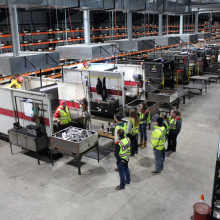Minnesota Chamber Foundation quarterly economic snapshot summer 2022
The Quarterly Economic Snapshot is an overview of key indicators measuring Minnesota’s current economic performance. Analysis is provided in partnership with Grow Minnesota! and the Minnesota Chamber Foundation.
Overview and highlights:
Minnesota’s economy showed mixed signals in the first half of 2022. Continued inflation, hiring challenges, a cooldown in GDP output, and uncertainty in consumer spending have negatively impacted business confidence and expectations for the coming year. On the other hand, Minnesota continued to recover job losses, increase labor force participation, decrease unemployment, grow state exports, and maintain elevated business formation levels so far this year.
While uncertainty and signs of cooling in the economy cloud the near-term outlook, Minnesota’s overall economic performance has remained relatively steady at the mid-year point.
Highlights:
-
Minnesota’s real GDP contracted by -2.0% in the first quarter of 2022 after experiencing six consecutive quarters of growth. Real GDP declined in 46 of 50 states in the first quarter, with U.S. real GDP falling by -1.6%. Minnesota GDP remains 1.0% above pre-pandemic peak levels, ranking 24th best among all states.
-
Minnesota exports grew by 13% in the first quarter of 2022 compared to the first quarter of 2021, trailing the U.S. growth rate of 18%. Exports to Canada alone were valued at $1.93 billion, a 35% increase from Q1 2021.
-
New business applications remain high through June of 2022, though they have fallen slightly from 2021 levels. Total applications from January-June 2022 remain 47% higher than the sixteen-year average from 2005-2020. This continues the pandemic-era trend of elevated business formation activity.
-
Total nonfarm payroll employment plateaued in June 2022, reaching 2,914,800 jobs on a seasonally adjusted basis. Total employment expanded by just 100 jobs from the previous month and grew 2.7% year-over-year. As of June 2022, Minnesota remained 80,700 payroll jobs below pre-pandemic levels.
-
Minnesota’s unemployment rate again reached a new record low in June 2022, declining to 1.8% on a seasonally adjusted basis. Minnesota had the second lowest unemployment rate in the nation in June.
-
Labor Force Participation Rate (which measures the share of adults 16 and older who are working or actively looking for work) inched up to 68.5% in June, marking the sixth consecutive month of workforce participation gains. However, Minnesota still has 69,426 fewer workers in the labor force (either employed or actively seeking employment) compared to February 2020.
-
U.S. inflation continued to rise in June 2022, with prices climbing 9.1% higher than a year prior in June 2021. The combination of rising prices, hiring challenges, and fears of a recession have dampened business confidence to the lowest levels since the pandemic’s beginning.
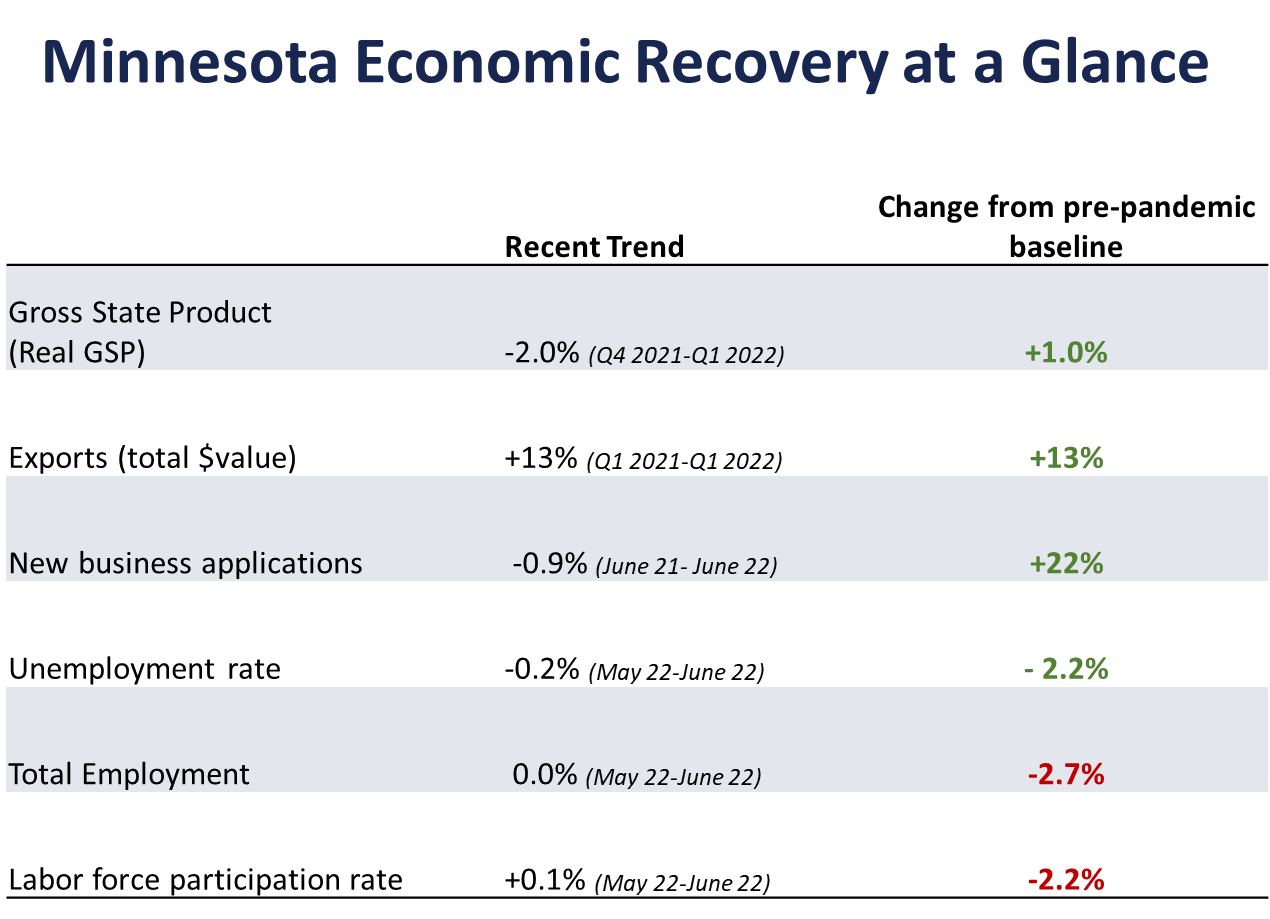
GDP
Minnesota’s economy showed signs of cooling, with real GDP declining by -2.0%
- Minnesota’s real GDP fell by -2.0% in the first quarter of 2022, ranking 30th best among all states. Real GDP declined by -1.6% in the U.S. economy.
- This marks the first decline in GDP since the second quarter of 2020 when GDP plummeted by a staggering 29% in Minnesota and 31% in the U.S.
- Minnesota GDP remains 1.0% above pre-pandemic levels. While Minnesota lags other states in job recovery, it ranks 24th in GDP growth from Q4 2019 (pre-pandemic peak) to Q1 2022.
- There was significant variation in GDP changes by sector in the first quarter, ranging from a -25% decline in mining output to a positive 28.5% gain in agriculture, forestry, fishing and hunting. Overall, twelve sectors expanded output in the first quarter while eight declined.
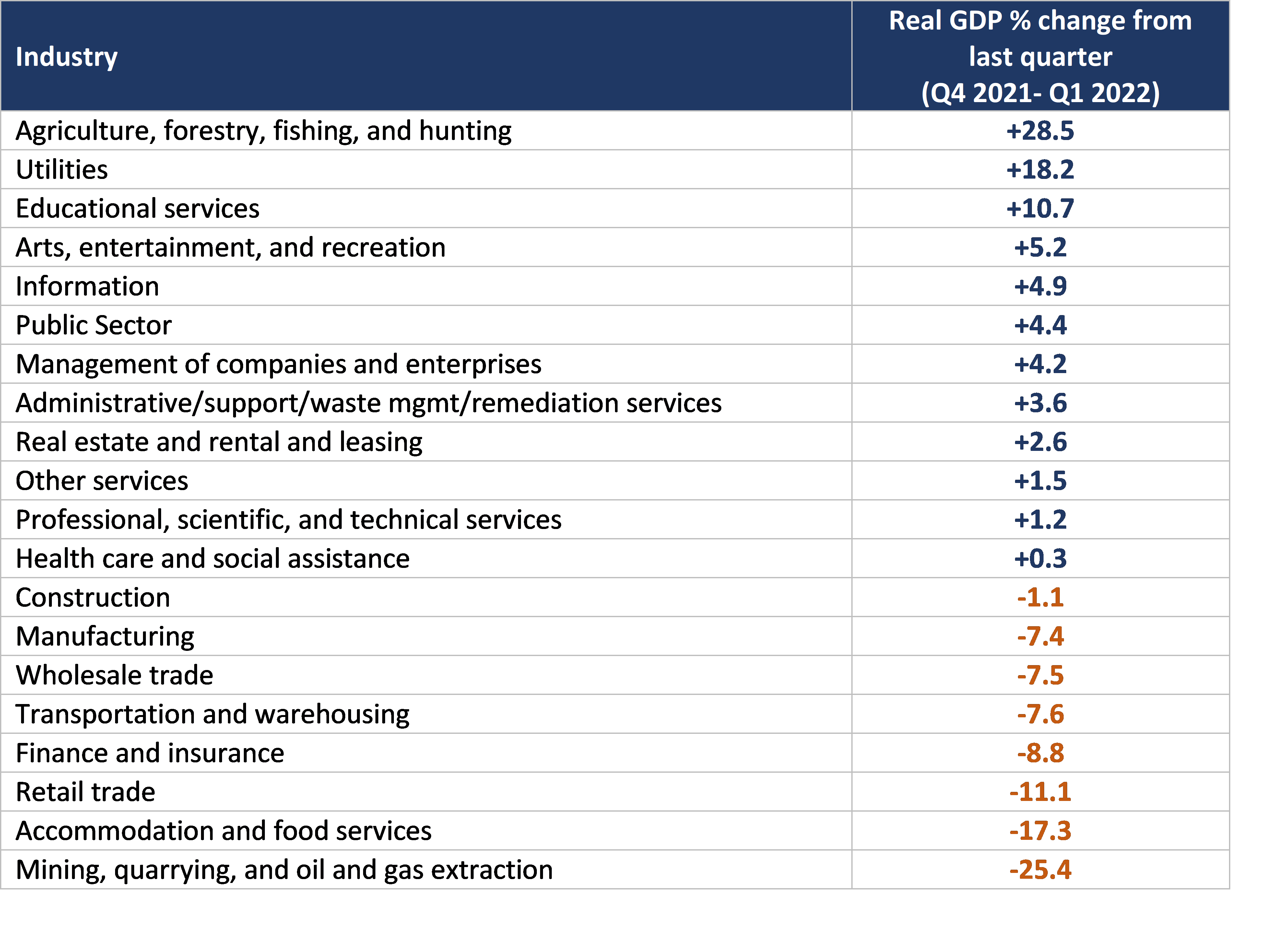
Source: Minnesota Chamber of Commerce analysis of Bureau of Economic Analysis data
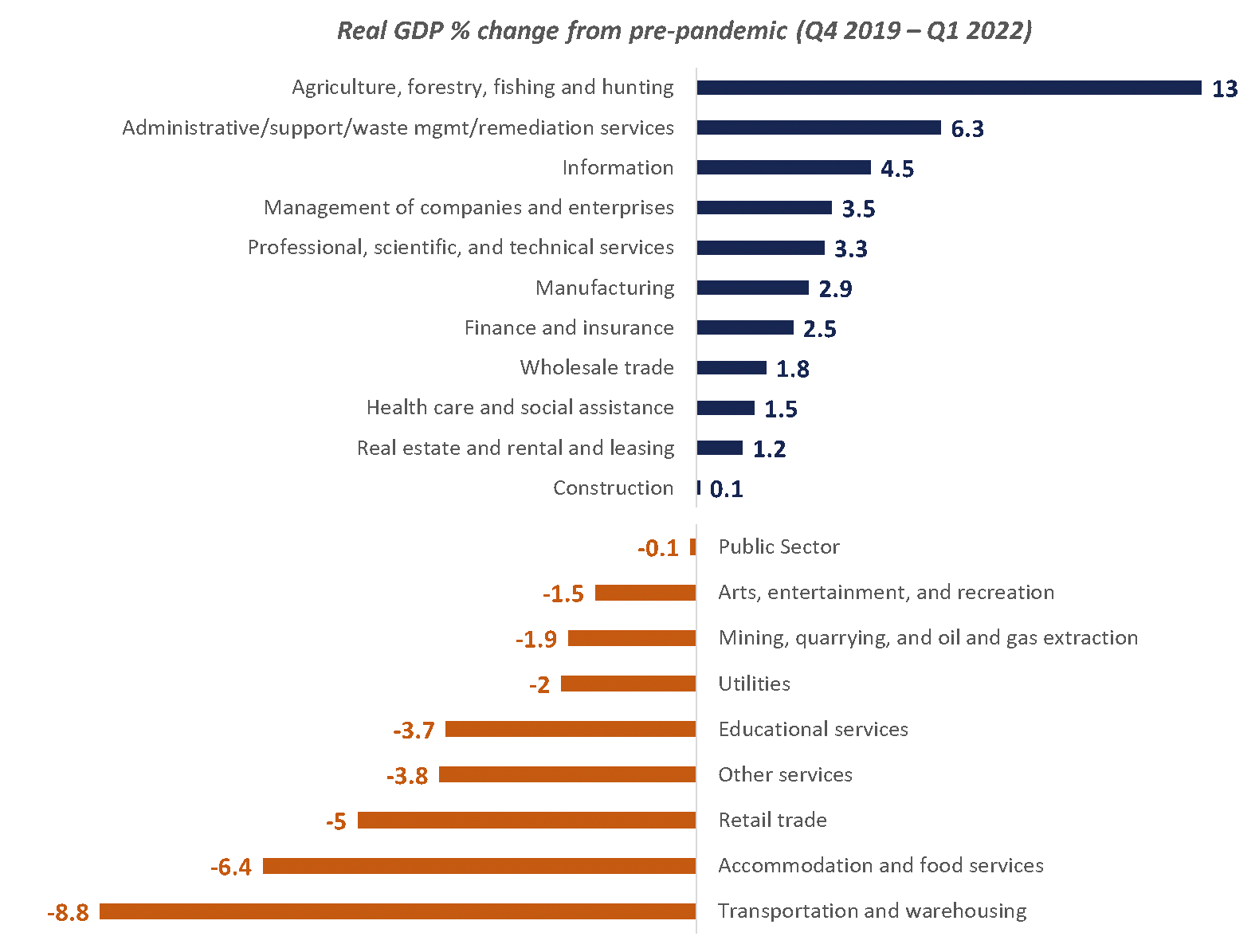

EXPORTS
Minnesota exports continued to grow in the first quarter of 2022.
- Minnesota exports were valued at $6.1 billion in Q1 2022, a 13% increase from the first quarter of the previous year. State exports trailed slightly behind U.S. exports which saw 18% growth in the first quarter.
- Among Minnesota’s top 20 largest export markets, state exports increased to ten countries and declined to the other ten. Most notably, exports to Canada – Minnesota’s largest trading partner by far – accelerated since pre-pandemic times, growing by 87% since 2019. Exports to China – Minnesota’s second largest export market – also grew by 24% during this time frame.
- Additional growth markets for Minnesota include Malaysia (86%), Costa Rica (56%), Netherlands (36%), and Brazil (27%).
Source: Minnesota Chamber analysis of Bureau of Economic Analysis data
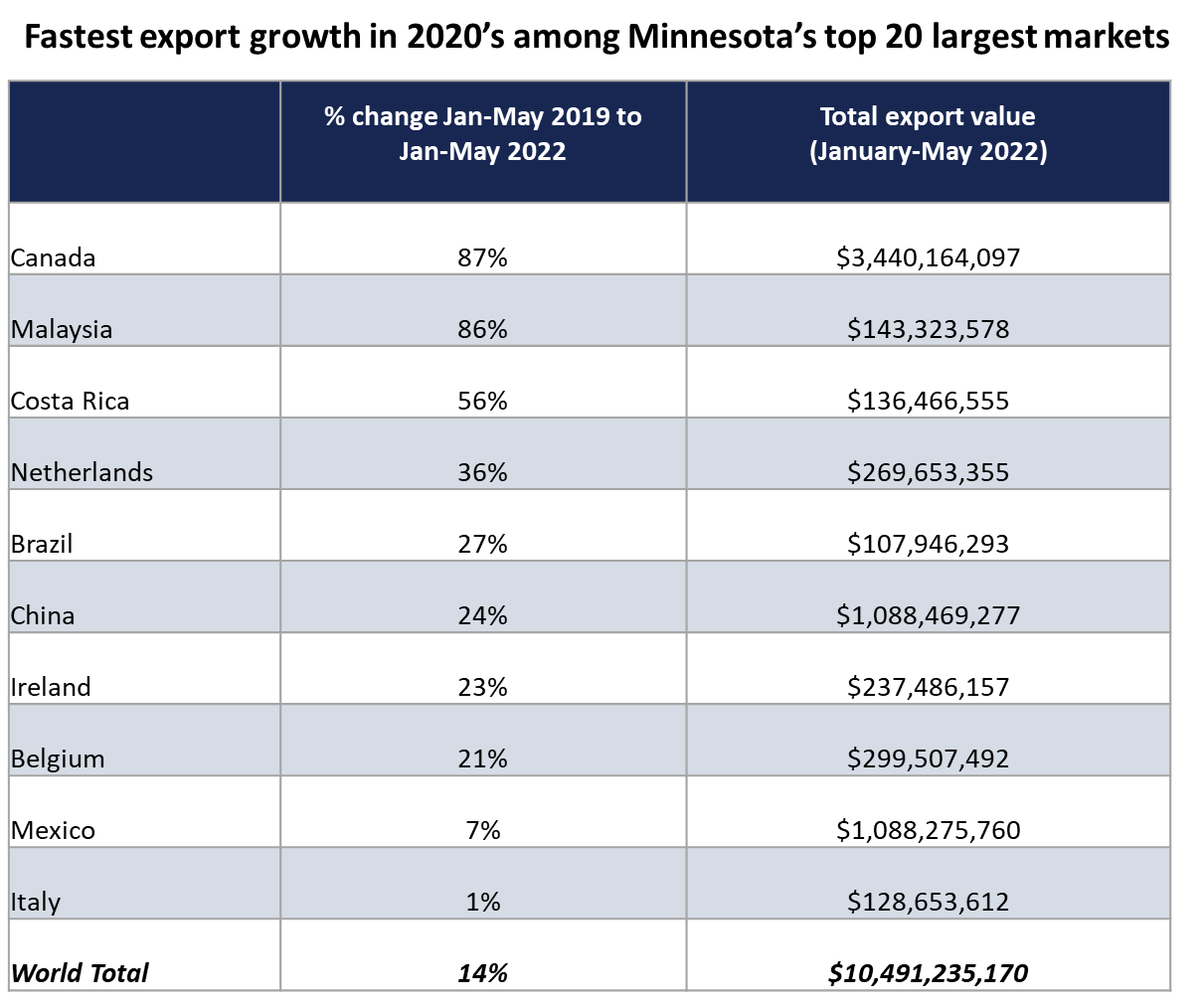
Source: Minnesota Chamber of Commerce analysis of U.S. Census Bureau data
Startup activity remains elevated through the first half of 2022, though new planned new business starts have ebbed slightly from 2021 levels.
- Entrepreneurs filed a total of 30,605 new business applications from January to June of 2022. While this is off the pace of 2021 levels, it is still 47% higher than the sixteen-year average from 2005-2020. In other words, Minnesotans filed roughly 10,000 more new business applications than in the first half of a typical pre-pandemic year.
- Minnesota venture capital activity continued to surge in the first half of 2022. Data from Pitchbook shows that 78 Minnesota startups raised $929 million in total deal value in the first half of the year. This value ranks as the 20th most VC deals and 18th highest deal value among all states (please note that these are preliminary data and are subject to future revisions).
- An annual report by Startup Genome ranked Minneapolis as the 4th top emerging startup ecosystem in the world and 2nd in the U.S., further demonstrating the strengthening of startup activity, funding, and support services in the region.
- However, a recent report from Pitchbook warns of potential headwinds in U.S. venture capital markets, which have already begun to reduce IPO filings and impact late-stage startups. While overall VC dealmaking remained solid in H1 2022, they warn that “the pace of VC activity across all stages is likely to slow in H2 2022 as the threshold for closing deals rises and pricing uncertainty extends to the early stages of the investment cycle.” This is an area for further tracking in the months to come.
- Read here for a complete analysis of Minnesota entrepreneurship trends released by the Minnesota Chamber Foundation in April 2022.
Job Growth
Minnesota job recovery comes to a standstill as employers struggle to find workers.
- Total payroll employment increased by just 100 jobs in June, reaching 2,914,800 jobs on a seasonally adjusted basis. Total employment growth was flat at 0.0% from the previous month and grew 2.7% year-over-year.
- Minnesota remained 80,700 jobs below pre-pandemic employment levels as of June 2022, with job recovery ranking 37th nationally.
- The bi-annual Job Vacancy Survey showed that Minnesota had the highest job vacancy rate on record in Q4 2021, with more than twice as many open positions as unemployed individuals in the state. As unemployment continues to reach record lows and workforce participation recovers at a slow rate, the state’s labor supply continues to be unable to meet demand.
- Total employment grew in eight industries in June, seven shed jobs, and another three were flat.
- Compared to pre-pandemic employment levels, only five of 20 Minnesota industries have reached or surpassed the full recovery mark, while another 15 have yet to recover the jobs lost in 2020. Professional, scientific and technical services saw the largest job gains since the beginning of 2020, followed by manufacturing and construction.
Source: Current Employment Statistics, Minnesota DEED
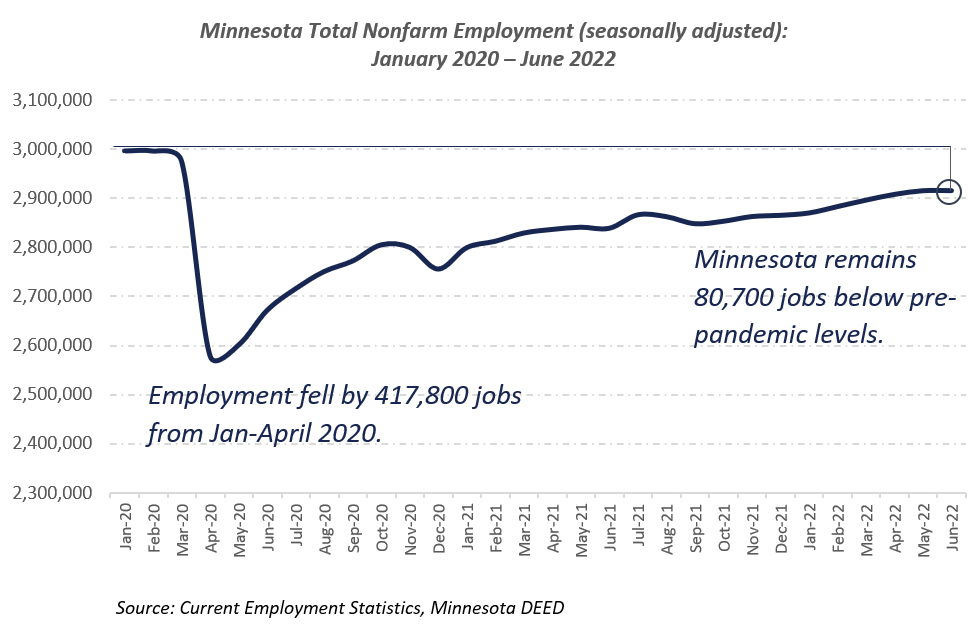
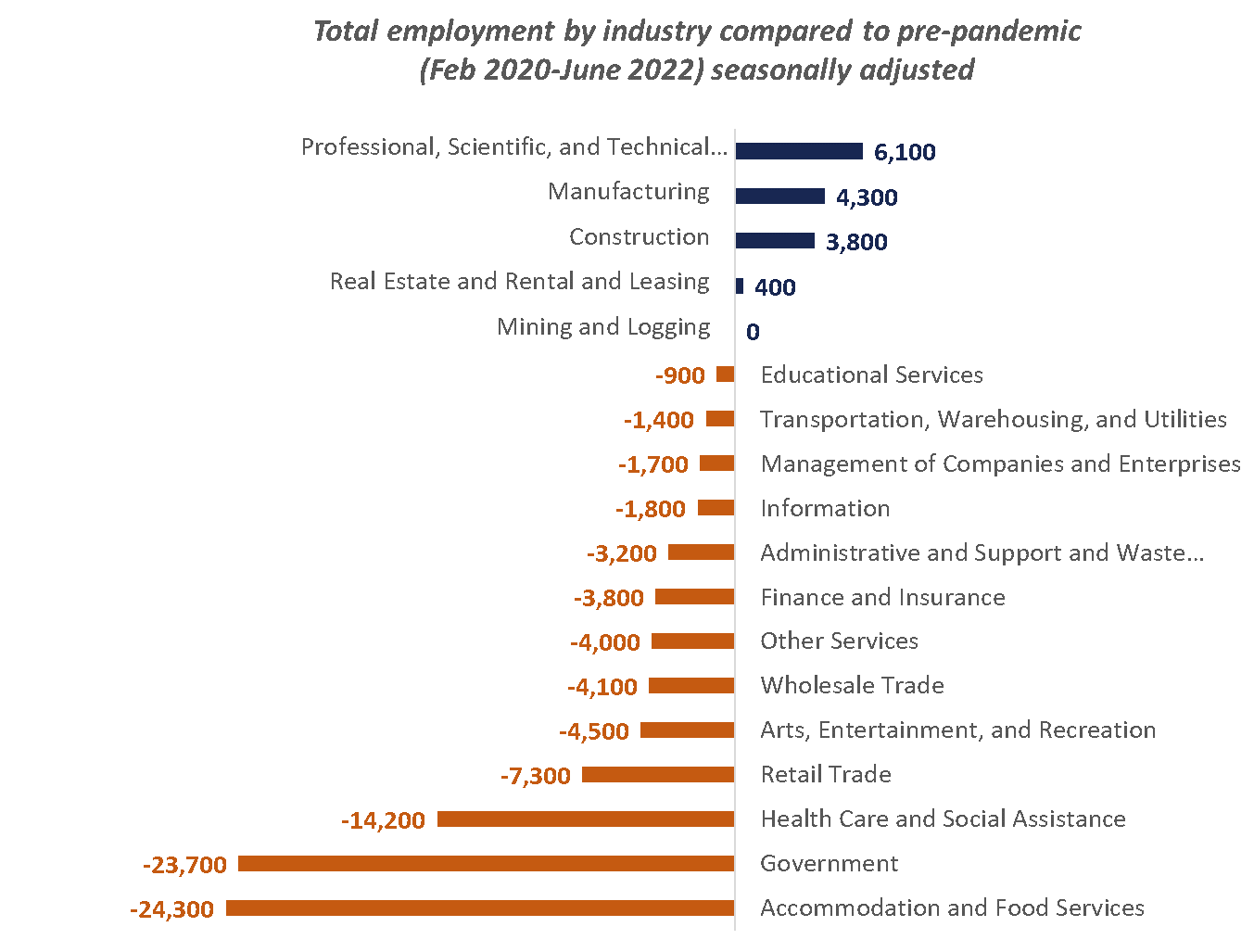
UNEMPLOYMENT AND LABOR FORCE PARTICIPATION
Minnesota reaches new record low unemployment rate (again), while labor force participation creeps up slowly.
- Minnesota’s unemployment rate again reached a new record low in June, declining to 1.8% on a seasonally adjusted basis. The previous record prior to 2022 occurred in 1999, when Minnesota’s unemployment rate hit 2.5% amidst the economic boom of the late ‘90s. Minnesota’s unemployment rate has now broken below that prior record for a third consecutive month.
- Despite record unemployment rates and rising wages, Minnesotans who left the workforce during the pandemic have not yet come back in large numbers. The state’s labor force participation rate crept up to 68.5% in June, bringing an additional 5,432 individuals into the workforce. This leaves Minnesota with 69,426 fewer workers in the labor market than before the pandemic. While Minnesota is not alone in this trend, the state had the second largest decline in total labor force since the end of 2019 among Midwestern states. Only Iowa had more significant decreases in its labor force during that time.
- The continued supply and demand imbalance in the labor market has significantly halted job recovery and negatively impacted overall business sentiment.
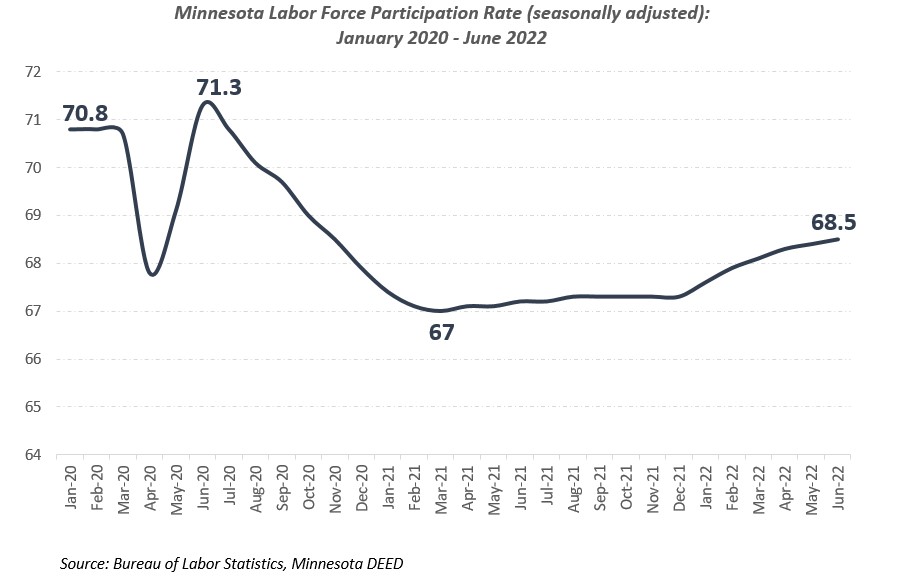
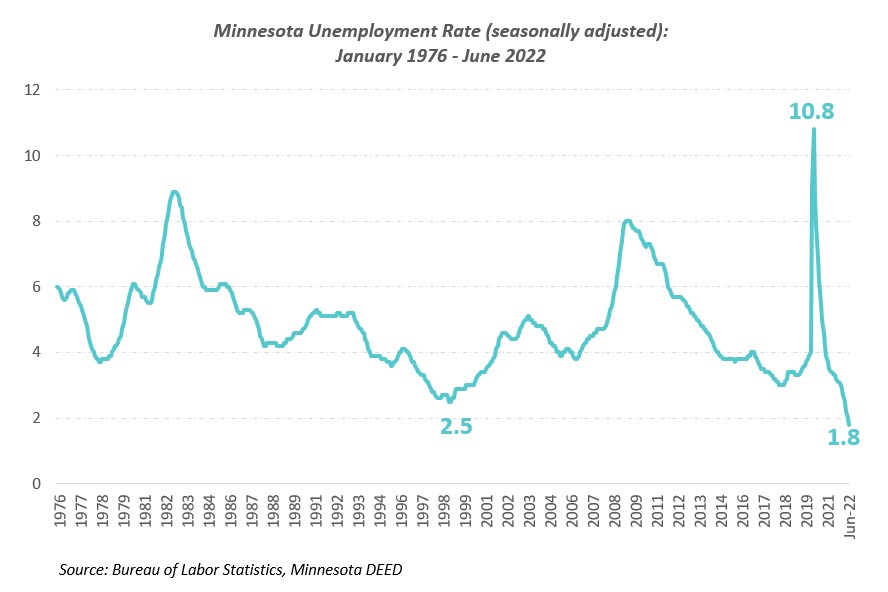
SUPPLY CHAIN AND INFLATION
Continued inflation clouds the future economic outlook
- U.S. inflation continued to rise in June 2022, with prices climbing 9.1% higher than a year prior in June 2021.
- The continued combination of inflation and hiring challenges appears to be impacting businesses’ outlook. A May-June survey of business service firms by DEED and the Minneapolis Federal Reserve showed that 85% of respondents expect increased inflation in the coming year and 43% expect declines in consumer spending and corporate profits.
- Similarly, the June Mid-American Economy survey – conducted each month by Creighton University – reported its lowest level business confidence index level since the beginning of the pandemic. Supply managers in Minnesota reported a slowdown in new orders in June, with an index reading of 42, down from 63 in May (anything above 50 indicates expansion). However, other indicators remained in positive territory, and Minnesota’s overall business conditions index rose to 68.6, up from 62.3 in May. While businesses show pessimism over the future outlook, current business activity remained positive.




